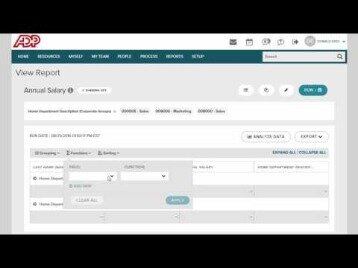While core net income increased, GAAP net income fell, primarily due to the formulaic rise in incentive fees. Unlike core net income, GAAP net income does not strip out capital gains incentive fees attributable to net realized / unrealized gains / losses. We expect fee income to continue to recover through the year, taking advantage of stronger seasonality and a boost in market sentiment from rising equity prices. Our 2023 target is to keep cost growth to approximately 3%, adjusted for currency effects and notable items. Our acquisition of SVB UK, and the related investments internationally, are expected to add approximately 1% to the Group‘s operating expenses.
- Interest on bonds issued by state and local governments generally is not subject to federal taxation.
- The Census Bureau’s 2020 Supplemental Poverty Measure rate was 2.3 percentage points lower than the official poverty rate of 11.4%.
- The AGI share of the top 1 percent fluctuates considerably over the business cycle, rising with expansions and falling with contractions to a greater extent than income reported by other groups.
- This balance is then transferred to the retained earnings account in a journal entry like this.
- When you transfer income and expenses to the income summary, you close out the relevant revenue and expense accounts for the period.
The third entry closes the Income Summary account to Retained Earnings. The fourth entry closes the Dividends account to Retained Earnings. The information needed to prepare closing entries comes from the adjusted trial balance. This means that it is not an asset, liability, stockholders’ equity, revenue, or expense account. The account has a zero balance throughout the entire accounting period until the closing entries are prepared. Therefore, it will not appear on any trial balances, including the adjusted trial balance, and will not appear on any of the financial statements.
The Entries for Closing a Revenue Account in a Perpetual Inventory System
Gross income means the total value of one’s salary or payments, without accounting for any cash outflows. Net income refers to the income left over after subtracting taxes or fees. For individual earners, discretionary income is the amount they have available after paying for necessary expenses. The trial balance, after the closing entries are completed, is now ready for the new year to begin.
Macau Casino Revenue Surges in July as Summer Fuels Holiday … – Bloomberg
Macau Casino Revenue Surges in July as Summer Fuels Holiday ….
Posted: Tue, 01 Aug 2023 04:55:25 GMT [source]
The business is said to make profits if the credit portion of the income summary statement is more than the debit side of the income summary statement. Similarly, the business is said to make losses if the debit portion of the income summary statement is more than the credit side of the income summary statement. All temporary accounts of revenue and expenses have to be first transferred into the temporary statement of income and summary account.
By doing so, the income summary account displays the net results of the company for a financial period. The income summary account in a credit position means the company has made a profit and the income summary account in a debit position means the company has made a loss. Accountants use an account called the income summary to close the year for temporary accounts. The purpose of this article is to define the income summary account and look at a helpful overview so that this account becomes less of a mystery. [2] The average tax rate was computed by dividing total income tax (see footnote 1) by adjusted gross income.
Why Use the Income Summary Account?
To close the income summary account, the balance in the account needs to be transferred to a capital account (generally the retained earnings). The trial balance above only has one revenue account, Landscaping Revenue. If the account has a $90,000 credit balance and we wanted to bring the balance to zero, what do we need to do to that account? In order to cancel out the credit balance, we would need to debit the account. The company can make the income summary journal entry by debiting the income summary account and crediting the retained earnings if the company makes a net income.
Now that we have closed the temporary accounts, let’s review what the post-closing ledger (T-accounts) looks like for Printing Plus. Closing entries prepare a company for the next accounting period by clearing any outstanding balances in certain accounts that should not transfer over to the next period. Closing, or clearing the balances, means returning the account to a zero balance. Having a zero balance in these accounts is important so a company can compare performance across periods, particularly with income. It also helps the company keep thorough records of account balances affecting retained earnings.
To update the balance in Retained Earnings, we must transfer net income and dividends/distributions to the account. By closing revenue, expense and dividend/distribution accounts, we get the desired balance in Retained Earnings. We need to complete entries to update the balance in Retained Earnings so it reflects the balance on the Statement of Retained Earnings. We know the change in the balance includes net income and dividends. Therefore, we need to transfer the balances in revenue, expenses and dividends (the temporary accounts) into Retained Earnings to update the balance.
We added it to Retained Earnings on the Statement of Retained Earnings. To add something to Retained Earnings, which is an equity account with a normal credit balance, we would credit the account. Each of these accounts must be zeroed out so that on the first day of the year, we can start tracking these balances for the new fiscal year. Remember that the periodicity principle states that financial statements should cover a defined period of time, generally one year. This may seem like pointless extra work, as you can transfer the data directly from the income statement to the balance sheet. Transferring revenue and expenses to the income summary creates a paper trail.
Types of Income
Therefore, learning about income summaries and other accounting tools in business is imperative. The formula for calculating the total retained earnings is revenue minus expenses. In this case, the total retained earnings are listed as credit because the revenue (credited) was more significant than the expenses.

It increases — or in the case of a net loss, decreases — retained earnings. Unlike some bookkeeping accounts, the income summary doesn’t track or record any new information. The financial data in the income summary is all on the income statement. However, there are a couple of significant differences between them.
Income Summary vs. Income Statement
He is the sole author of all the materials on AccountingCoach.com. Josh Pupkin is a member of WSO Editorial Board which helps ensure the accuracy of content across top articles on Wall Street Oasis. Josh adp 2020 has extensive experience private equity, business development, and investment banking This content was originally created by member WallStreetOasis.com and has evolved with the help of our mentors.

For example, taxpayers with AGI between the top 10th and 5th percentiles ($154,589 and $221,572) paid an average income tax rate of 13.3 percent—3.8 times the rate paid by taxpayers in the bottom 50 percent. The income summary account is important for any accountant or business owners that are preparing financial statements. It allows for transactions to be reflected correctly in the right financial period as long as it is accurately closed out at the end of every financial period.
That makes it much easier for auditors to later confirm that amounts in the balance sheet and elsewhere are legitimate. As you can see, the income and expense accounts are transferred to the income summary account. Once a company determines whether it has sustained a loss or earned a profit, the results from the final account are typically transferred into retained earnings on the balance sheet. After closing the revenue accounts, the next step in compiling the document is to close all the expense accounts.
- ARCC remains on the cheaper end of BDCs that have generated total NAV returns in the low double-digits over the last 5 years.
- This net balance of income summary represents the net income if it is on the credit side.
- The weighted-average EBITDA of its junior debt borrowers is on the order of $400m with a weighted-average LTV below 50%.
- The closing entry will credit Supplies Expense, Depreciation Expense–Equipment, Salaries Expense, and Utility Expense, and debit Income Summary.
- These accounts carry forward their balances throughout multiple accounting periods.
[3] The average tax rate was computed by dividing total income tax (see footnote 2) by adjusted gross income. The top 1 percent (taxpayers with AGI of $546,434 and above) earned 20.1 percent of total AGI in 2019 and paid 38.8 percent of all federal income taxes. Readers should note the IRS dataset excludes the refundable portion of tax credits such as the earned income tax credit, which means the IRS data overstates the tax rate paid by taxpayers at the bottom. Modern-day accounting software typically does the process of automatically debiting or crediting revenue and expense balances once the accounting period ends. The first step in preparing it is to close all the revenue accounts. Closing entries play a significant role in producing the accounts as they move the temporary account balances to permanent accounts on the balance sheet.
Company
In public policy, income represents the basis for most forms of taxation. Taxable income is the total of all income from all sources and in any form, minus any tax-exempt amounts or allowable deductions. Michelle P. Scott is a New York attorney with extensive experience in tax, corporate, financial, and nonprofit law, and public policy. As General Counsel, private practitioner, and Congressional counsel, she has advised financial institutions, businesses, charities, individuals, and public officials, and written and lectured extensively. This account is a great tool to show the net profit or loss of a company for any financial years.

I imagine some of you are starting to wonder if there is an end to the types of journal entries in the accounting cycle! So far we have reviewed day-to-day journal entries and adjusting journal entries. This net balance of income summary represents the net income if it is on the credit side. On the other hand, if it is on the debit, it presents the net loss of the company. The data demonstrates the U.S. individual income tax continues to be progressive, borne primarily by the highest income earners. Looking at the revenue account balance, all the revenue-generating sources, whether operating or non-operating business functions are included in the process.
